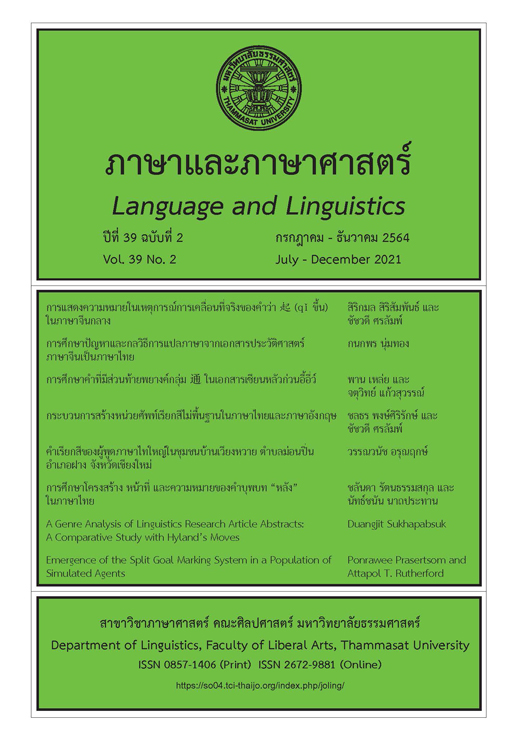Lexicalization of Non-Basic Color Terms in Thai and English
Main Article Content
Abstract
This research purposes to examine and draw a comparison between lexicalization for non-basic color terms in Thai and English. The data used within this study were collected from the Facebook fan-page Thaitone and XKCD’s website. The results of the study reveal two categories of lexicalization: 1) compounding and 2) metaphorical meaning. Color terms, entities, and assorted words were combined to form a compound word in compounding strategy whilst simile, metaphor, and metonymy were applied in a metaphorical meaning procedure. The results also reveal the difference between the proportion of lexicalization in Thai and English. Compared to English, non-basic color terms in Thai make use of more metaphorical meaning procedures. On the other hand, English adopts more compounding strategies as a main process in comparison to Thai.
Article Details
บทความทุกบทความเป็นลิขสิทธิ์ของภาษาและภาษาศาสตร์
References
ณรงค์กรรณ รอดทรัพย์. (2555). คำเรียกสีในภาษาม้งขาว. วารสาร มฉก. วิชาการ, 16, 77-88.
ณรงค์กรรณ รอดทรัพย์. (2557). คำเรียกสีในภาษาอูรักลาโว้ยถิ่นภูเก็ต. วารสารปาริชาต มหาวิทยาลัยทักษิณ, 27(3), 66-79.
ธนัฏฐากุล พรทิพยพานิช. (2557). คำเรียกสีภาษาไทยสมัยธนบุรีและสมัยรัตนโกสินทร์[วิทยานิพนธ์ปริญญามหาบัณฑิต]. มหาวิทยาลัยเกษตรศาสตร์.
พิกุล ภูชมศรี. (2561). คำเรียกสีในภาษาไทยถิ่นอีสาน. วารสารภาษา ศาสนา และวัฒนธรรม 7(1), 103-122.
ไพโรจน์ พิทยเมธี. (2559). การสร้างประสบการณ์ทางสุนทรียะจากสีไทย [วิทยานิพนธ์ปริญญาดุษฎีบัณฑิต]. มหาวิทยาลัยศิลปากร.
ราชบัณฑิตยสถาน. (2556). พจนานุกรมฉบับราชบัณฑิตยสถาน พ.ศ. 2554. นานมีบุ๊คส์พับลิเคชั่นส์.
วิพาที ทิพย์คงคา. (2553). คำเรียกสีในสมัยอยุธยา [วิทยานิพนธ์ปริญญามหาบัณฑิต]. มหาวิทยาลัยเกษตรศาสตร์.
ศุภมาส เอ่งฉ้วน. (2543). คำเรียกสีและมโนทัศน์เรื่องสีของคนไทยสมัยอยุธยาและสมัยปัจจุบัน [วิทยานิพนธ์ปริญญาดุษฎีบัณฑิต]. จุฬาลงกรณ์มหาวิทยาลัย.
ศราวุธ หล่อดี. (2561). คำเรียกสีและมโนทัศน์เกี่ยวกับสีในภาษาล้านนา [วิทยานิพนธ์ปริญญาดุษฎีบัณฑิต]. มหาวิทยาลัยพะเยา.
อภิญญา เพชรวิชิต. (2545). การสร้างคำเรียกสีในภาษาไทยและภาษาลาว. [สารนิพนธ์ปริญญามหาบัณฑิต]. มหาวิทยาลัยมหาสารคาม.
Berlin, B., & Kay, P. (1969). Basic color terms: Their universality and evolution. University of California Press.
Conti, S. (2006). Compound adjectives in English: A descriptive approach to their morphology and functions [Unpublished doctoral dissertation]. University of Pisa.
Drocco, A., & Risato, O. (2019). Lexicalization patterns in colour naming: The case of modern Hindi. In I. Raffaelli, D. Katunar, & B. Kerovec (Eds.), Lexicalization patterns in color naming: A cross-linguistic perspective (pp. 191-211). John Benjamins Publishing.
Katamba, F. (1993). Morphology. Macmillan.
Knickerbocker, K. L., & Reninger, H. W. (1963). Interpreting Literature. Holt, Rinehart and Winsten.
Lakoff, G. (1987). Women, fire, and dangerous things what categories reveal about the mind. University of Chicago Press.
Lindsey, D. T., & Brown, A. M. (2014). The color lexicon of Amercan English. Journal of Vision, 14(2), 17. https://doi.org/10.1167/14.2.17
O'Grady, W., Dobrovolsky, M., & Aronoff, M. (1997). Contemporary linguistics: An introduction. St. Martin’s Press.
Regier, T., Kay, P., & Khetarpal, N. (2007). Color naming reflects optimal partitions of color space. Proceedings of the National Academy of Sciences, 104(4), 1436-1441.
Shemin, C. (2014). Disney's the Muppets character encyclopedia. DK Publishing.
Thaitone. (2020, October 15). Thaitone color [Infographic]. Facebook. https://www.facebook.com/thaitonecolor/photos/1833810606762178
Ullmann, S. (1962). Semantics: An introduction to the science of meaning. Blackwell.
XKCD. (2010). The 954 Most common RGB monitors colors by several
hundred thousand participants in the XKCD color name survey. https://xkcd.com/color/rgb/
Yule, G. (2005). The study of language (3rd ed.). Cambridge University Press.


